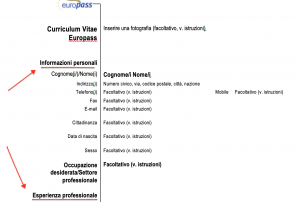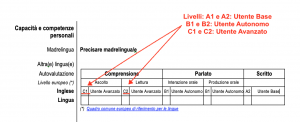How to write your resume (CV)
Learning how to write a CV is very important for the job search. The CV describes all the jobs you have done and your skills. It helps introduce you when looking for a job. Find out how to write a CV in Italian.
The resume, also called Curriculum Vitae or CV, is a summary of your professional life. The resume is your first chance to make a good impression when you apply for a job. It allows you to introduce yourself and explain your professional experiences, your training, and your interests.
Why do I need a resume?
You need a resume every time you apply for a job. You can send it to companies even if they haven’t posted a job vacancy to let them know that you would like to work for them. Employers will decide whether to invite you for an interview based on what they read. It is therefore important to know how to write a good resume!
How long should my resume be?
Experts say a resume should be 1 or 2 pages long. Employers have to read a lot of resumes very quickly. therefore, your information must be clear and not too long.
How do I create my resume?
The main pieces of information that the curriculum must include are:
- Who you are. Personal details (name, surname, date of birth, etc) and your personal contacts (email, telephone number, etc) are important.
- What training you have. The skills you have acquired in school, training course or through work experience.
- Your work experience. Write down previous work experience, the roles and tasks you performed in these activities.
- Your goals. The role you envision for yourself in the future. You can write a short description of your profile in your CV, explaining why you are applying. You can also decide to include this in your cover letter as a short introduction.
Here are some tips for creating a good resume and including all required information:
Your resume information needs to be clear, well organized, and easy to follow. Write your personal details at the top along with your contact details. Use separate sections to list your studies, work experience, skills, qualifications and any other important information.

Adding a photo of yourself to your resume is advisable, but not mandatory. If you decide to add one, use a recent photo that only shows your face, or head and shoulders. It should be recent and with a neutral background. Avoid images that show bare arms and cleavage, photos with friends, family or animals, and photos in non-professional locations (on the beach, at the bar, etc).
Clearly write your personal and contact details. It will be the main reference for your future employer during the selection process.
- Write your name first, followed by your surname. Married women must write the same surname that they use in official documents. Do not put academic titles (such as a Dr., Engr.) before your personal details.
- According to Italian law, it is not mandatory to write the birthdate and the place of birth on the CV. But if you decide to do so, then write down the date first and then the place. If you were born in another country, please specify the city and country.
For example: “Date and place of birth: March 20th, 1987 – Tirana, Albania”
- According to Italian law, it is also not mandatory to write your home address on the CV. You can simply just put the city where you live. If you want to write the address as well, then remember to add the house number and postcode as well. The first letter of the street, city and country name is capitalized. Write the province in parentheses.
For example: “Via Gaspare Farulla, 14 – 70043 Monopoli (BA)”
- Writing your phone number and email address is essential to be contacted. Use an Italian telephone number to avoid problems. Separate the first three numbers.
For example: 329-xxxxxxx o 329/xxxxxxx
- If you have a LinkedIn profile, you can also add the link to your profile.
- Double-check carefully that there are no errors.
Start with your most recent work experience or your current position, even a volunteering one, and continue listing up to the oldest job. List your most important experiences without going too far back in time.
- Write the start and end dates, the work you have done and the name of the company you worked for. If you are currently working, you can write the start date followed by “- present” (or –in corso) to indicate that is your current position.
- Briefly explain the role, tasks and responsibilities. For example: A porter in a hotel performs various tasks, such as carrying luggages, arranging and cleaning the hall, and parking cars.
Important: customize your resume for each application.
Customizing means changing to fit the situation. Focus on the work experiences that are most important to the job you are applying for. Describe less relevant jobs more briefly. You can also add internships/apprenticeship, especially if they are relevant to the job you are applying for.
It is very important to write all about your studies. Write the name of the school, or schools, you attended and all certifications or diplomas obtained. For the studies, as for work experiences, list the schools starting with the most recent at the top and continuing to the first school.
- Write the full name of the institution or university where you studied and the exact start and end dates of your studies;
- If you obtained good grades or a particular recognition, it would be useful to write it down;
- If the institution where you studied is particularly important and recognized in your country, it is important that you write it down. For example: “2005 – 2019: Makerere University, Kampala. The oldest university in Uganda and one of the best academic institutions in Africa“.
If you know one or more foreign languages, write it in your resume. Languages can be very beneficial for many jobs, especially in tourist cities!
Specify the level of your proficiency in a language in your resume. To do so, refer to the Common European Framework of Reference for Languages (CEFR)
Read information about the CEFR

Also write down the period of time spent in other countries during which you used another language to speak or for work. Add how this experience helped you improve your language skills.
Your resume needs to show your best side, on the personal and professional level. One of the most important parts of the CV is a clear (and honest) description of your practical and interpersonal skills.
- Practical skills (“hard skills”) are skills related specifically to a particular job that you have learned during a training or professional experience. For example: If you are an expert in using the sewing machine or a program on your computer, this is a practical skill that you must indicate. You can use all of your qualifications, training, and work experience to prove that you have the technical skills required for the job.
- Relational skills (“soft skills”) are the personal skills you have showing you can work well. They describe your work style, for example: you are quick to learn, or that you take the time to make sure you are doing things correctly.
An important relational competence is knowing how to relate to people. Make sure that the interpersonal skills you want to write in the CV are those in line with the job offer.
Here is a formula for listing relationship skills on your resume: relationship skills + circumstance (in life or work) + achieved goal.
For example, you could say:
Punctuality – thanks to my ability to always be punctual, I was in charge of a delivery for some important clients at work. The customers greatly appreciated my punctuality and felt respected. This has improved the recognition of my work and favored the opinion about the company.
Among the recommended fonts to use for a professional resume are Helvetica, Arial and Times New Roman. These fonts give the resume a clear and neat look.
The appropriate font size is 12. For headings, or details, you can use a slightly larger or smaller size. Using bold for headings is also preferable.
Complete your curriculum by authorizing the processing of your personal data under the GDPR privacy law. If you do not sign your curriculum, the employer may not consider it.
You can authorize the use of your data by writing: “I authorize the processing of my personal data according to the 2016/679 European Union regulation”-“Autorizzo il trattamento dei miei dati personali in base al regolamento 2016/679 dell’Unione Europea” and then sign the curriculum.
Save the resume in the format that is most convenient for you. But use the PDF format to send it to the employer.
- Saving your resume in its original format, such as Microsoft Word, will allow you to update it and customize it for different applications. You can name it for example “[your name] curriculum.1”.
- If you update it, you can replace the old version, in order not to get confused between the old version and the new one. For example “[your name] curriculum.2”.
- If instead you customize it, save it as a different file and add the name of the employer you sent it to so that you remember. For example, “[your name] curriculum.1 – sent to [company name].”
- Be sure to include your name in the PDF file name when attaching it to a job application or email. A file with the name “my resume” will not be useful to the employer. You can write for example: “name.surname.CV”.